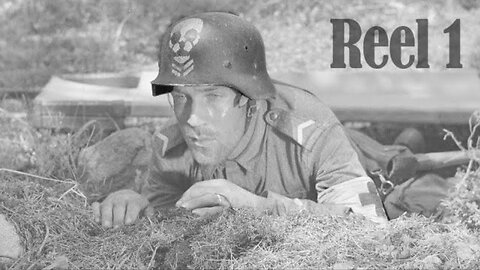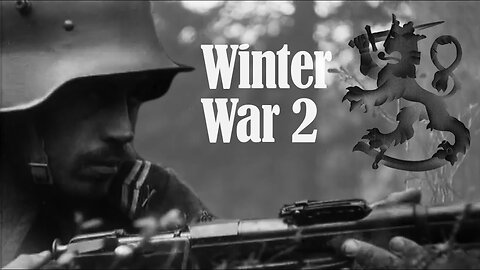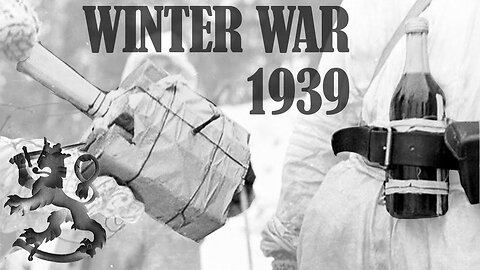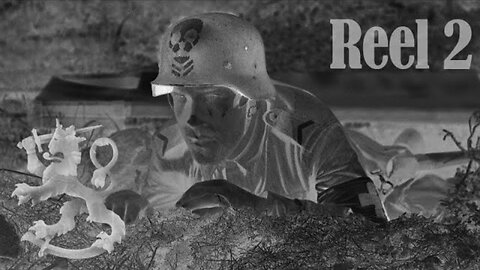
-
1943 COMBAT TRAINING - Medical Service of the Finnish Army in the Winter - Reel 2
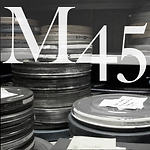 Military1945SUPPORT THE CHANNEL and get access to exclusive film footage www.Patreon.com/Military1945 Episode 198 This film is an English Language version of a captured German army film, entitled "Der Sanitaetsdienst der Finnischen Wehrmacht im Winter" which is best translated as "The Medical Service of the Finnish Army in the Winter". The severe Finnish Wintermakes precautionary measures necessary for protection against freezing of the wounded. The use of paper proved itself an appropriate remedy. It is good protection against wind and cold. Though paper was used only as an improvisation, the satisfactory results have brought about the extensive utilization of this material. The individual pieces are now industrially manufactured in great quantities. They compine with their outstanding value as protection against cold, the advantages of remarkable low cost and repeated use, even under heavy strain.16 views
Military1945SUPPORT THE CHANNEL and get access to exclusive film footage www.Patreon.com/Military1945 Episode 198 This film is an English Language version of a captured German army film, entitled "Der Sanitaetsdienst der Finnischen Wehrmacht im Winter" which is best translated as "The Medical Service of the Finnish Army in the Winter". The severe Finnish Wintermakes precautionary measures necessary for protection against freezing of the wounded. The use of paper proved itself an appropriate remedy. It is good protection against wind and cold. Though paper was used only as an improvisation, the satisfactory results have brought about the extensive utilization of this material. The individual pieces are now industrially manufactured in great quantities. They compine with their outstanding value as protection against cold, the advantages of remarkable low cost and repeated use, even under heavy strain.16 views -
1943 COMBAT TRAINING - Medical Service of the Finnish Army in the Winter - Reel 1
 Military1945SUPPORT THE CHANNEL and get access to exclusive film footage www.Patreon.com/Military1945 Episode 196 This film is an English Language version of a captured German army film, entitled "Der Sanitaetsdienst der Finnischen Wehrmacht im Winter" which is best translated as "The Medical Service of the Finnish Army in the Winter". The severe Finnish Wintermakes precautionary measures necessary for protection against freezing of the wounded. The use of paper proved itself an appropriate remedy. It is good protection against wind and cold. Though paper was used only as an improvisation, the satisfactory results have brought about the extensive utilization of this material. The individual pieces are now industrially manufactured in great quantities. They compine with their outstanding value as protection against cold, the advantages of remarkable low cost and repeated use, even under heavy strain.16 views 2 comments
Military1945SUPPORT THE CHANNEL and get access to exclusive film footage www.Patreon.com/Military1945 Episode 196 This film is an English Language version of a captured German army film, entitled "Der Sanitaetsdienst der Finnischen Wehrmacht im Winter" which is best translated as "The Medical Service of the Finnish Army in the Winter". The severe Finnish Wintermakes precautionary measures necessary for protection against freezing of the wounded. The use of paper proved itself an appropriate remedy. It is good protection against wind and cold. Though paper was used only as an improvisation, the satisfactory results have brought about the extensive utilization of this material. The individual pieces are now industrially manufactured in great quantities. They compine with their outstanding value as protection against cold, the advantages of remarkable low cost and repeated use, even under heavy strain.16 views 2 comments -
WINTER WAR 1939/40 Pt 2 + Series intro covering war diary SS Einsatzgruppen, Pogrom, "Evacuation"
 Military1945SUPPORT THE CHANNEL and get access to exclusive film footage www.Patreon.com/Military1945 Episode 195 In part 1 of this series we saw footage from Nov. of 1939 of the Winter War between Finland and the Soviet Union without narration. Here In part 2, the footage of Finnish soldiers continues however this time I’ll take the opportunity to introduce a new war diary that will be made into a series and then to describe the state of our channel Military1945. At the end of the episode I’ve added some nice combat footage from 1942. M45 has predominately gained its subscriber base by creating videos that follow original German war diaries. We integrate other primary historical sources for example, OKW situational maps, newspaper articles and photographs..Enabled by our Patreon supporters I’ve managed to buy an another fantastic new war diary. This one was written by a member of the Feldgendarmerie which was a type of German military police that covers his service in Russia during Barbarossa. Feldgendarmerie were employed within army divisions and as self-contained units, our author was in Trupp 240, under the command of an army corps. They often worked in close cooperation with the Geheime Feldpolizei, or Secret Field Police, district commanders and SS and Police Leaders. The 103 page diary goes from April of 1941, through May of 42 and describes the author’s experiences first as part of the 170 ID which was in the 11th Army in AGS and then working in a hospital situated in Xerson in the Ukraine. As part of the German security apparatus in occupied Russia he writes about atrocities for example the shooting of Jews by Romanian forces, pogroms perpetrated by civilians, executions of jews by SS Einsatzgruppen or death squads, and the ominous evacuation of all the residents of a town that had been suspected of passing on information to the Soviets. A story he relates involves a 19-year old Wehrmacht soldier who literally takes possession of a village, begins collecting taxes and shooting civilians who don’t respect his authority. The author develops a friendship with the an SS officer, the hospital’s head doctor, who eventually becomes his protector. Over months they discuss human evolution, NS racial theory, and religion. Ironically both individuals are christians but seem to have no problem with the violence and racism that swirls around them. While promiscuous activity with the nurses might be looked down upon, the murder of innocent civilians isn’t contemplated at all. His duties at the hospital, along with acting as an assistant doctor, include representing defendants in military court cases for example a doctor who organized the looting of a supply train and then divided up the booty among his subordinates. and interviewing German soldiers that had gone AWOL to decide whether their absence had been legitimate or not. In addition to his diary are 3 reports covering these soldiers stories, a 13-page report of his general impression of Russia and a candid 6-page summary describing his service in the east. In creating this material, it’s not my intention to build empathy for the author but rather to gain insight into the thoughts and feelings of participants in the events. These added layers of detail help to make our unbiased understanding of the war in Russia a little more complete. I’d like thank our Patreon supporters who have made the purchase of this war diary collection possible. To be honest, without their help the continued development of Military1945 wouldn’t be possible. In appreciation, Patreon member get regular access to exclusive footage that can’t be shown here. The new war diary collection is for sale, if you are interested in finding out about it please go to Military1945.com and message me from there. Recently we’ve been playing with the content mix of material being produce hoping to expand the scope of viewers that our videos are shown to. In addition to episodes which follow original diaries we’ve uploaded a few presentations from the conference a 21st Century Look at June 22, 1941, for example covering Operation Beowulf the German invasion of the Baltic Islands in Sept. 1941. These episodes done in a more traditional style we’ve sexed up by integrating rare associated film footage from our massive archive. Moving forwards the M45 content mix will be approximately 30% war diaries, 30% traditional historical presentations, 30% raw footage like part 1 of the Winter War series and 10% culturally relevant films like the 1926 silent film Faust which will soon be uploaded. I’ll also begin releasing video shorts again. Military1945 currently has just over 22,100 subscribers and depending on the channel’s growth, that content mix will be adjusted. The trick is to interest new groups of subscribers while remaining true to those that we already have. If you have any feedback regarding anything related to the Military1945 project please leave a comment below and I will respond.164 views
Military1945SUPPORT THE CHANNEL and get access to exclusive film footage www.Patreon.com/Military1945 Episode 195 In part 1 of this series we saw footage from Nov. of 1939 of the Winter War between Finland and the Soviet Union without narration. Here In part 2, the footage of Finnish soldiers continues however this time I’ll take the opportunity to introduce a new war diary that will be made into a series and then to describe the state of our channel Military1945. At the end of the episode I’ve added some nice combat footage from 1942. M45 has predominately gained its subscriber base by creating videos that follow original German war diaries. We integrate other primary historical sources for example, OKW situational maps, newspaper articles and photographs..Enabled by our Patreon supporters I’ve managed to buy an another fantastic new war diary. This one was written by a member of the Feldgendarmerie which was a type of German military police that covers his service in Russia during Barbarossa. Feldgendarmerie were employed within army divisions and as self-contained units, our author was in Trupp 240, under the command of an army corps. They often worked in close cooperation with the Geheime Feldpolizei, or Secret Field Police, district commanders and SS and Police Leaders. The 103 page diary goes from April of 1941, through May of 42 and describes the author’s experiences first as part of the 170 ID which was in the 11th Army in AGS and then working in a hospital situated in Xerson in the Ukraine. As part of the German security apparatus in occupied Russia he writes about atrocities for example the shooting of Jews by Romanian forces, pogroms perpetrated by civilians, executions of jews by SS Einsatzgruppen or death squads, and the ominous evacuation of all the residents of a town that had been suspected of passing on information to the Soviets. A story he relates involves a 19-year old Wehrmacht soldier who literally takes possession of a village, begins collecting taxes and shooting civilians who don’t respect his authority. The author develops a friendship with the an SS officer, the hospital’s head doctor, who eventually becomes his protector. Over months they discuss human evolution, NS racial theory, and religion. Ironically both individuals are christians but seem to have no problem with the violence and racism that swirls around them. While promiscuous activity with the nurses might be looked down upon, the murder of innocent civilians isn’t contemplated at all. His duties at the hospital, along with acting as an assistant doctor, include representing defendants in military court cases for example a doctor who organized the looting of a supply train and then divided up the booty among his subordinates. and interviewing German soldiers that had gone AWOL to decide whether their absence had been legitimate or not. In addition to his diary are 3 reports covering these soldiers stories, a 13-page report of his general impression of Russia and a candid 6-page summary describing his service in the east. In creating this material, it’s not my intention to build empathy for the author but rather to gain insight into the thoughts and feelings of participants in the events. These added layers of detail help to make our unbiased understanding of the war in Russia a little more complete. I’d like thank our Patreon supporters who have made the purchase of this war diary collection possible. To be honest, without their help the continued development of Military1945 wouldn’t be possible. In appreciation, Patreon member get regular access to exclusive footage that can’t be shown here. The new war diary collection is for sale, if you are interested in finding out about it please go to Military1945.com and message me from there. Recently we’ve been playing with the content mix of material being produce hoping to expand the scope of viewers that our videos are shown to. In addition to episodes which follow original diaries we’ve uploaded a few presentations from the conference a 21st Century Look at June 22, 1941, for example covering Operation Beowulf the German invasion of the Baltic Islands in Sept. 1941. These episodes done in a more traditional style we’ve sexed up by integrating rare associated film footage from our massive archive. Moving forwards the M45 content mix will be approximately 30% war diaries, 30% traditional historical presentations, 30% raw footage like part 1 of the Winter War series and 10% culturally relevant films like the 1926 silent film Faust which will soon be uploaded. I’ll also begin releasing video shorts again. Military1945 currently has just over 22,100 subscribers and depending on the channel’s growth, that content mix will be adjusted. The trick is to interest new groups of subscribers while remaining true to those that we already have. If you have any feedback regarding anything related to the Military1945 project please leave a comment below and I will respond.164 views -
Finnish-Russian WINTER WAR of 1939/40 - Raw footage of planes, destroyed Soviet column and POWs
 Military1945SUPPORT THE CHANNEL and get access to exclusive film footage www.Patreon.com/Military1945 Episode 194 The Winter War was a war between the Soviet Union and Finland. It began with a Soviet invasion of Finland on 30 November 1939, three months after the outbreak of World War II, and ended three and a half months later with the Moscow Peace Treaty on 13 March 1940. Despite superior military strength, especially in tanks and aircraft, the Soviet Union suffered severe losses and initially made little headway. The League of Nations deemed the attack illegal and expelled the Soviet Union. The Soviets made several demands, including that Finland cede substantial border territories in exchange for land elsewhere, claiming security reasons – primarily the protection of Leningrad, 32 km (20 mi) from the Finnish border. When Finland refused, the Soviets invaded. Most sources conclude that the Soviet Union had intended to conquer all of Finland, and cite the establishment of the puppet Finnish Communist government and the Molotov–Ribbentrop Pact's secret protocols as evidence of this, while other sources argue against the idea of a full Soviet conquest. Finland repelled Soviet attacks for more than two months and inflicted substantial losses on the invaders in temperatures as low as −43 °C (−45 °F). The battles focused mainly on Taipale along the Karelian Isthmus, on Kollaa in Ladoga Karelia and on Raate Road in Kainuu, but there were also battles in Salla and Petsamo in Lapland. After the Soviet military reorganized and adopted different tactics, they renewed their offensive in February 1940 and overcame the Finnish defences on the Karelian Isthmus. Hostilities ceased in March 1940 with the signing of the Moscow Peace Treaty in which Finland ceded 9% of its territory to the Soviet Union. Soviet losses were heavy, and the country's international reputation suffered. Their gains exceeded their pre-war demands, and the Soviets received substantial territories along Lake Ladoga and further north. Finland retained its sovereignty and enhanced its international reputation. The poor performance of the Red Army encouraged German Chancellor Adolf Hitler to believe that an attack on the Soviet Union would be successful and confirmed negative Western opinions of the Soviet military.After 15 months of Interim Peace, in June 1941, Germany commenced Operation Barbarossa, and the Continuation War between Finland and the Soviets began.27 views
Military1945SUPPORT THE CHANNEL and get access to exclusive film footage www.Patreon.com/Military1945 Episode 194 The Winter War was a war between the Soviet Union and Finland. It began with a Soviet invasion of Finland on 30 November 1939, three months after the outbreak of World War II, and ended three and a half months later with the Moscow Peace Treaty on 13 March 1940. Despite superior military strength, especially in tanks and aircraft, the Soviet Union suffered severe losses and initially made little headway. The League of Nations deemed the attack illegal and expelled the Soviet Union. The Soviets made several demands, including that Finland cede substantial border territories in exchange for land elsewhere, claiming security reasons – primarily the protection of Leningrad, 32 km (20 mi) from the Finnish border. When Finland refused, the Soviets invaded. Most sources conclude that the Soviet Union had intended to conquer all of Finland, and cite the establishment of the puppet Finnish Communist government and the Molotov–Ribbentrop Pact's secret protocols as evidence of this, while other sources argue against the idea of a full Soviet conquest. Finland repelled Soviet attacks for more than two months and inflicted substantial losses on the invaders in temperatures as low as −43 °C (−45 °F). The battles focused mainly on Taipale along the Karelian Isthmus, on Kollaa in Ladoga Karelia and on Raate Road in Kainuu, but there were also battles in Salla and Petsamo in Lapland. After the Soviet military reorganized and adopted different tactics, they renewed their offensive in February 1940 and overcame the Finnish defences on the Karelian Isthmus. Hostilities ceased in March 1940 with the signing of the Moscow Peace Treaty in which Finland ceded 9% of its territory to the Soviet Union. Soviet losses were heavy, and the country's international reputation suffered. Their gains exceeded their pre-war demands, and the Soviets received substantial territories along Lake Ladoga and further north. Finland retained its sovereignty and enhanced its international reputation. The poor performance of the Red Army encouraged German Chancellor Adolf Hitler to believe that an attack on the Soviet Union would be successful and confirmed negative Western opinions of the Soviet military.After 15 months of Interim Peace, in June 1941, Germany commenced Operation Barbarossa, and the Continuation War between Finland and the Soviets began.27 views
